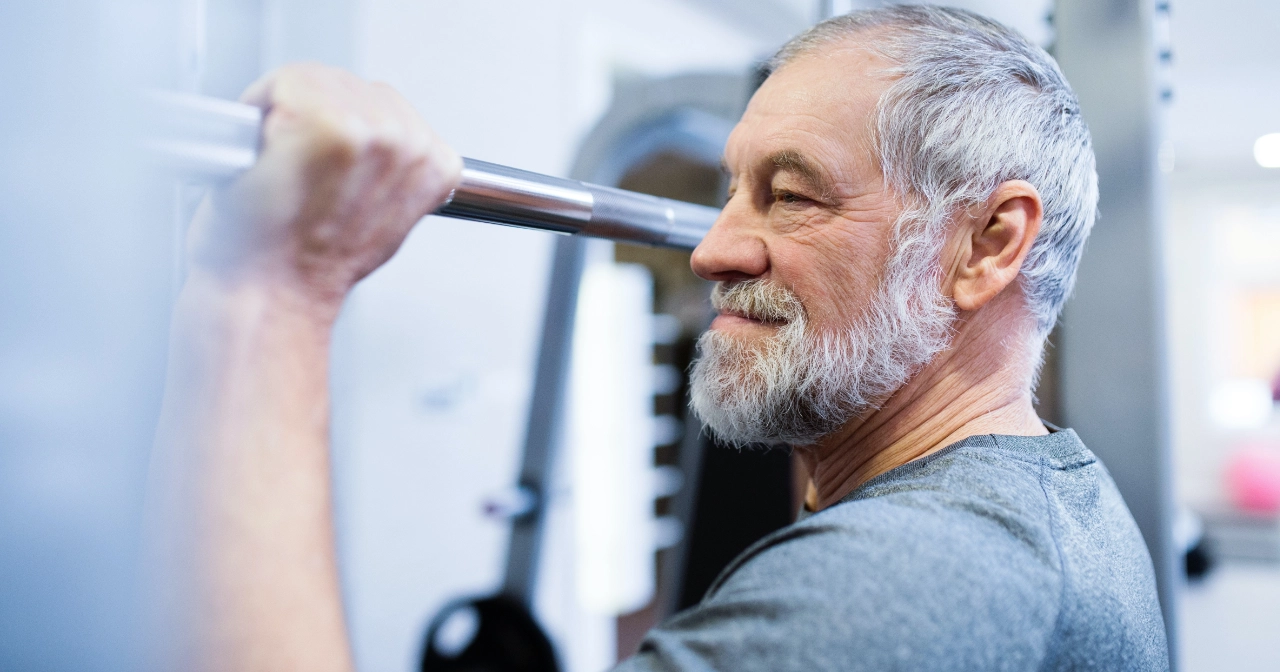Listen on: Apple Podcasts | Spotify
Muscle loss is a common yet preventable part of the aging process. As we age, muscle mass naturally decreases due to a decrease in physical activity and slowed metabolism. This process is known as sarcopenia, and it can have long-term health implications if not addressed. In this article, we’ll discuss the importance of muscle, why it’s so difficult to build in the first place, and how to prevent age-related muscle loss.
The Importance of Muscle Preservation
Higher levels of muscle mass offer myriad health benefits. One significant advantage is that muscles act as metabolic powerhouses. They burn calories even when we’re at rest, helping to maintain optimal body weight and prevent obesity.1Wolfe, RR. “The underappreciated role of muscle in health and disease.” The American journal of clinical nutrition 84.3 (2006): 475-482.
Muscle tissue also plays a pivotal role in improving insulin sensitivity, reducing the risk of type 2 diabetes.2Srikanthan, Preethi, and Arun S. Karlamangla. “Relative muscle mass is inversely associated with insulin resistance and prediabetes. Findings from the third National Health and Nutrition Examination Survey.” The Journal of Clinical Endocrinology & Metabolism 96.9 (2011): 2898-2903. The greater the muscle mass, the more glucose our bodies utilize, reducing the chance of diabetes development.
For mobility, muscle mass contributes to better balance and stability, which becomes crucial as we age.3Landi, Francesco, et al. “Sarcopenia as the biological substrate of physical frailty.” Clinics in geriatric medicine 31.3 (2015): 367-374. This enhanced stability reduces the likelihood of falls and injuries, contributing to a longer and healthier life.
Muscles also regulate our body’s response to inflammation and infection. A study by Johns Hopkins University found that individuals with solid muscle mass had a stronger immune response.4Fiuza-Luces, Carmen, et al. “Exercise is the real polypill.” Physiology 28.5 (2013): 330-358.
Moreover, preserving muscle mass aids in maintaining mental well-being. Research reveals a strong correlation between muscle strength and improved mood, reduced anxiety, and decreased instances of depression.5Gordon, Brett R., et al. “Association of efficacy of resistance exercise training with depressive symptoms meta-analysis and meta-regression analysis of randomized clinical trials.” JAMA psychiatry 75.6 (2018): 566-576.
So, muscle mass is not just about physical strength and aesthetics but a keystone of our overall health and longevity.
Why Is It So Difficult to Build Muscle?
Muscle hypertrophy, or the increase in muscle mass, is a complex process that becomes increasingly difficult as we age. This phenomenon is orchestrated by several factors, including hormones, proteins, and our bodies’ connective tissues.
Testosterone and growth hormone are two crucial players in muscle building. These hormones function like biochemical foremen, directing the construction and repair of muscle tissue. Testosterone promotes protein synthesis, the process by which the body uses dietary protein to build new muscle fibers.6West, D. W., & Phillips, S. M. (2012). Associations of exercise-induced hormone profiles and gains in strength and hypertrophy in a large cohort after weight training. European journal of applied physiology, 112(7), 2693-2702. On the other hand, growth hormone stimulates cell growth and regeneration, playing an integral part in muscle repair and recovery.7Devesa, J., Almengló, C., & Devesa, P. (2016). Multiple effects of growth hormone in the body: Is it really the hormone for growth?. Clinical medicine insights. Endocrinology and diabetes, 9, Cmed-88159.
However, with advancing age, our bodies naturally produce less of these hormones. This reduction results in slower muscle growth and recovery, making muscle building more challenging.8Pritzlaff, C. J., Wideman, L., Weltman, J. Y., Abbott, R. D., Gutgesell, M. E., Hartman, M. L., … & Weltman, A. (1999). Impact of acute exercise intensity on pulsatile growth hormone release in men. Journal of Applied Physiology, 87(2), 498-504.
Collagen is another significant factor in muscle building. It forms a crucial component of our musculoskeletal system, serving as the connective tissue within our bones and tendons. This protein acts as the body’s adhesive, anchoring muscles to bones and allowing the force generated by our muscles to be effectively transferred to our skeletal system, facilitating movement.9Zdzieblik, D., Oesser, S., Baumstark, M. W., Gollhofer, A., & König, D. (2015). Collagen peptide supplementation in combination with resistance training improves body composition and increases muscle strength in elderly sarcopenic men: a randomised controlled trial. British Journal of Nutrition, 114(8), 1237-1245.
As we age, collagen production declines, weakening the connection between muscles and bones and undermining the efficiency of our movements.10Elango, R., Humayun, M. A., Ball, R. O., & Pencharz, P. B. (2008). Evidence that protein requirements have been significantly underestimated. Current opinion in clinical nutrition and metabolic care, 11(1), 75-82. This can make muscle building more challenging and contribute to the overall decrease in muscle mass as we age, a condition known as sarcopenia.11Cruz-Jentoft, A. J., Bahat, G., Bauer, J., Boirie, Y., Bruyère, O., Cederholm, T., … & Landi, F. (2019). Sarcopenia: revised European consensus on definition and diagnosis. Age and ageing, 48(1), 16-31.
The physiological realities of aging – the reduction in vital hormones and collagen – create a challenging environment for muscle building. By understanding these complexities, you can adopt more effective strategies for maintaining and building muscle mass as you age.
How Quickly Do We Lose Muscle?
Muscle loss, especially when sudden or rapid, can be a cause for concern. What’s even more alarming is how quickly we can lose muscle mass if we cease engaging in physical activities like weight lifting, become immobile due to injury or illness, or engage in excessive endurance training.12Clark, B.C., Manini, T.M. (2008) Sarcopenia ≠ Dynapenia. The journals of gerontology. Series A, Biological sciences and medical sciences, 63(8): 829-834.
Studies have shown that significant muscle loss can occur in as little as two weeks of immobility or disuse.13Wall, B.T., Dirks, M.L., van Loon, L.J.C. (2013). Skeletal muscle atrophy during short-term disuse: implications for age-related sarcopenia. Ageing Research Reviews, 12(4): 898-906. This is particularly relevant in the case of hospitalization or prolonged bed rest. Similarly, when we stop weight training, muscle atrophy (the process of muscle wasting) can start within a week and become noticeable in about two to three weeks.14Bruusgaard, J.C., Johansen, I.B., Egner, I.M., Rana, Z.A., Gundersen, K. (2010). Myonuclei acquired by overload exercise precede hypertrophy and are not lost on detraining. Proceedings of the National Academy of Sciences, 107(34): 15111-15116. This is part of why I was adamant about getting on my feet and trying to walk within a day after breaking my neck and having my cervical vertebrae fused. The longer I lay in bed, especially after such a severe injury, the more rapidly I would have lost muscle.
Engaging in excessive endurance training can also contribute to muscle loss. While endurance exercises like running and cycling can benefit cardiovascular health, they can decrease muscle mass if not balanced with strength training.15Wilson, J.M., Marin, P.J., Rhea, M.R., Wilson, S.M., Loenneke, J.P., Anderson, J.C. (2012) Concurrent training: a meta-analysis examining interference of aerobic and resistance exercises. Journal of Strength and Conditioning Research, 26(8): 2293-2307. This is because these activities preferentially burn muscle tissue for fuel, leading to a decrease in muscle mass over time.16Hawley, J.A., Hargreaves, M., Joyner, M.J., Zierath, J.R. (2014). Integrative biology of exercise. Cell, 159(4): 738-749.
The Impact of Aging on Muscle Loss
Aging significantly impacts muscle loss, a condition known as sarcopenia.17Cruz-Jentoft, A.J., Sayer, A.A. (2019). Sarcopenia. Lancet, 393(10191): 2636-2646. As we age, our bodies naturally start to lose muscle mass and function, which can have a detrimental effect on our overall health and quality of life.18Morley, J.E., Baumgartner, R.N., Roubenoff, R., Mayer, J., Nair, K.S. (2001). Sarcopenia. Journal of Laboratory and Clinical Medicine, 137(4): 231-243.
Muscle loss due to aging often begins as early as our 30s, and the process accelerates from our 50s onwards.19Janssen, I., Heymsfield, S.B., Wang, Z.M., Ross, R. (2000). Skeletal muscle mass and distribution in 468 men and women aged 18-88 yr. Journal of Applied Physiology, 89(1): 81-88. Various factors contribute to this, including a decrease in physical activity, changes in hormone levels, and a decline in the body’s ability to synthesize protein.20Volpi, E., Nazemi, R., Fujita, S. (2004). Muscle tissue changes with aging. Current Opinion in Clinical Nutrition & Metabolic Care, 7(4): 405-410.
Research has also shown that the quality of the muscle changes with age, with a reduction in the size and number of muscle fibers, as well as a decrease in the number of motor units.21Lexell, J., Taylor, C.C., Sjöström, M. (1988). What is the cause of the ageing atrophy? Total number, size and proportion of different fiber types studied in whole vastus lateralis muscle from 15- to 83-year-old men. Journal of the Neurological Sciences, 84(2-3): 275-294. This can lead to a decrease in strength and power, which can impact daily activities and increase the risk of falls and fractures.22Rubenstein, L.Z. (2006). Falls in older people: epidemiology, risk factors and strategies for prevention. Age and Ageing, 35(Supplement_2), ii37-ii41.
Weight Training Frequency in Muscle Growth and Retention
Weight training is a critical component for muscle growth and retention.23Peterson, M.D., Sen, A., Gordon, P.M. (2011). Influence of resistance exercise on lean body mass in aging adults: a meta-analysis. Medicine and science in sports and exercise, 43(2), 249. Resistance exercises stimulate a process known as muscle protein synthesis, which helps in building and restoring muscle fibers.24Damas, F., Phillips, S., Vechin, F.C., Ugrinowitsch, C. (2015). A review of resistance training-induced changes in skeletal muscle protein synthesis and their contribution to hypertrophy. Sports Medicine, 45(6), 801-807.
The frequency of weight training needed to stimulate muscle growth varies depending on factors such as age, overall health, and fitness level.25Ralston, G.W., Kilgore, L., Wyatt, F.B., Baker, J.S. (2017). The effect of weekly set volume on strength gain: a meta-analysis. Sports Medicine, 47(12), 2585-2601. Younger adults might see benefits with 2-3 sessions per week, while older adults may require more frequent or tailored sessions.26Latham, N.K., Bennett, D.A., Stretton, C.M., Anderson, C.S. (2004). Systematic review of progressive resistance strength training in older adults. The Journals of Gerontology Series A: Biological Sciences and Medical Sciences, 59(1), M48-M61.
Muscle loss can be significantly slowed or even reversed with regular weight training. Research indicates that even in older adults, substantial improvements in muscle mass and strength can be achieved through resistance training.27Peterson, M.D., Rhea, M.R., Sen, A., Gordon, P.M. (2010). Resistance exercise for muscular strength in older adults: a meta-analysis. Ageing Research Reviews, 9(3), 226-237. However, weight training needs to be a consistent part of one’s lifestyle, as muscle loss can resume if training is discontinued.28Wernbom, M., Augustsson, J., Thomeé, R. (2007). The influence of frequency, intensity, volume and mode of strength training on whole muscle cross-sectional area in humans. Sports Medicine, 37(3), 225-264.
Read also: Bigger is Better: The Case for Building Muscle at Every Age.
Combining Nutrition and Supplements with Resistance Training to Mitigate Muscle Loss
Effective nutrition and supplementation strategies can play an integral role in mitigating muscle loss and supporting muscle growth, alongside resistance training.29Morton, R.W., Murphy, K.T., McKellar, S.R., Schoenfeld, B.J., Henselmans, M., Helms, E., … & Phillips, S.M. (2017). A systematic review, meta-analysis and meta-regression of the effect of protein supplementation on resistance training-induced gains in muscle mass and strength in healthy adults. British Journal of Sports Medicine, 52(6), 376-384. A well-structured diet is vital for providing the needed nutrients to repair, maintain, and build muscle tissue.30Paddon-Jones, D., Westman, E., Mattes, R.D., Wolfe, R.R., Astrup, A., Westerterp-Plantenga, M. (2008). Protein, weight management, and satiety. American Journal of Clinical Nutrition, 87(5), 1558S-1561S.
Protein is essential due to its role in muscle protein synthesis. Consuming adequate protein, particularly after resistance training, stimulates muscle growth and recovery.31Cribb, P.J., Hayes, A. (2006). Effects of supplement timing and resistance exercise on skeletal muscle hypertrophy. Medicine & Science in Sports & Exercise, 38(11), 1918-1925. On the other hand, Creatine supplementation is known to enhance strength and muscle mass, primarily by increasing the muscles’ capacity to perform high-intensity work.32Kreider, R.B. (2003). Effects of creatine supplementation on performance and training adaptations. Molecular and cellular biochemistry, 244(1-2), 89-94. By helping you to train harder, you create a greater stimulus for muscle growth.
Branched-chain amino acids (BCAAs), which include leucine, isoleucine, and valine, are also crucial for muscle growth and recovery. Not only do BCAAs directly stimulate muscle protein synthesis, but they also help reduce muscle damage and promote faster recovery after intense workouts.33Shimomura, Y., Inaguma, A., Watanabe, S., Yamamoto, Y., Muramatsu, Y., Bajotto, G., … & Mawatari, K. (2010). Branched-chain amino acid supplementation before squat exercise and delayed-onset muscle soreness. International Journal of Sport Nutrition and Exercise Metabolism, 20(3), 236-244.
In addition to protein, creatine, and BCAAs, other supplements have demonstrated benefits for muscle health. For instance, Omega-3 fatty acids are known to stimulate muscle protein synthesis and mitigate muscle loss, especially in older adults.34Smith, G.I., Atherton, P., Reeds, D.N., Mohammed, B.S., Rankin, D., Rennie, M.J., & Mittendorfer, B. (2011). Dietary omega-3 fatty acid supplementation increases the rate of muscle protein synthesis in older adults: a randomized controlled trial. American Journal of Clinical Nutrition, 93(2), 402-412. Vitamin D also plays an important role in muscle function, with several studies showing that its supplementation can improve muscle strength, particularly in individuals with low vitamin D levels.35Bischoff-Ferrari, H.A., Dawson-Hughes, B., Staehelin, H.B., Orav, J.E., Stuck, A.E., Theiler, R., … & Henschkowski, J. (2009). Fall prevention with supplemental and active forms of vitamin D: a meta-analysis of randomised controlled trials. British Medical Journal, 339, b3692. Finally, HMB (beta-hydroxy-beta-methylbutyrate) may help slow muscle loss in older adults and enhance gains from resistance training.36Wilkinson DJ, Hossain T, Hill DS, Phillips BE, Crossland H, Williams J, Loughna P, Churchward-Venne TA, Breen L, Phillips SM, Etheridge T, Rathmacher JA, Smith K, Szewczyk NJ, Atherton PJ. Effects of leucine and its metabolite β-hydroxy-β-methylbutyrate on human skeletal muscle protein metabolism. J Physiol. 2013 Jun 1;591(11):2911-23. doi: 10.1113/jphysiol.2013.253203. Epub 2013 Apr 3. PMID: 23551944; PMCID: PMC3690694.
For older adults, creatine monohydrate and HMB could be two of the most powerful, and affordable, supplements you can find to minimize muscle loss.
Practical Summary
To combat muscle loss, there’s a lot you can do. But you should start with the choices that give you the biggest bang for your buck.
First, get on a good resistance training program if you’re not on one already. It is essential for increasing muscle size and slowing the rate of muscle loss as we age.
Second, eat more protein. A lot more. For women, get in 0.8 grams per pound ideal bodyweight. Men need 1.0 grams per ideal body weight per day.
Then, add in other options, such as supplements. Creatine is known for its strength and muscle mass-enhancing capabilities. Branched-chain amino acids (BCAAs) promote muscle recovery and growth. Omega-3 fatty acids and Vitamin D are also beneficial for muscle health. And HMB can slow muscle loss in older adults.
In conclusion, maintaining muscle mass requires a multi-faceted approach, combining resistance training, nutrition, and supplementation. By integrating these strategies into your routine, you can effectively mitigate muscle loss and promote muscle health, irrespective of your age.




Good read, not to long and to the point.
Loved it.
Keep it up sir.
If people haven’t purchased your book yet, I suggest they do so.
It compliments your material.
Thank you Sherwood!